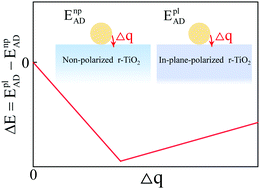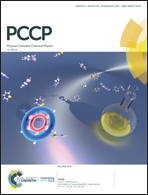Intrinsic interaction between in-plane ferroelectric polarization and surface adsorption†
Abstract
The chemical properties of a ferroelectric surface are polarization dependent, the underlying nature of which is, however, far from being completely understood. One of the reasons is that when the polarization direction is perpendicular to the surface, the depolarization field may induce electronic or atomic reconstruction and thus change the chemistry of the ferroelectric surface in complicated ways. Instead, the in-plane polarization results in no depolarization field. Therefore, the chemical properties of a ferroelectric surface can be more intrinsically reflected by the interplay between the in-plane polarization and the surface adsorption. By using first-principles calculations, we study the effect of the strain-induced in-plane polarization on the adsorption of a series of molecules on the reduced rutile TiO2(110) surface. We reveal that it is the surface doping caused by the charge transfer between the adsorbates and the TiO2(110) surface that dominates the polarization-induced change of the adsorption energy, as a result of screening long-range Coulomb interactions. The electrostatic interaction between the polarization of the substrate and the polar molecule is of relatively less importance. We propose that charge transfer effects generally occur for ferroelectric surfaces with no localized surface states.



 Please wait while we load your content...
Please wait while we load your content...